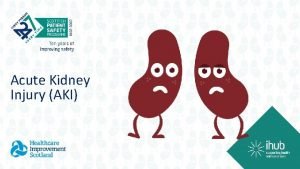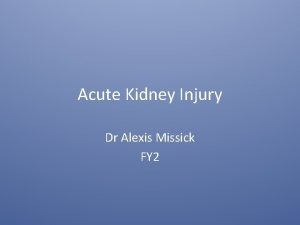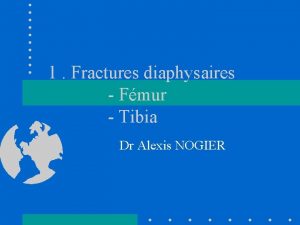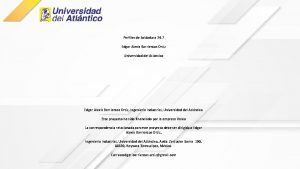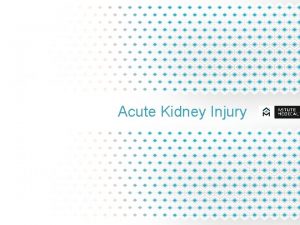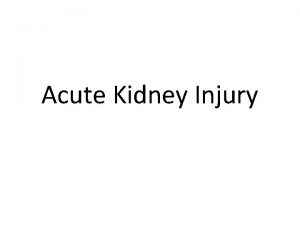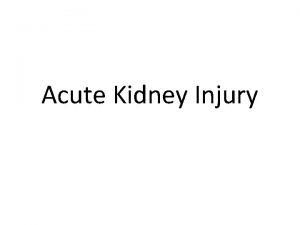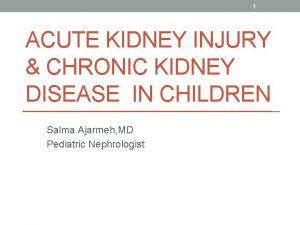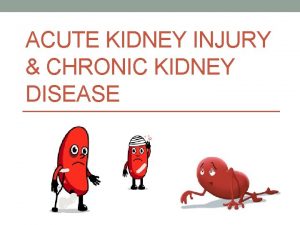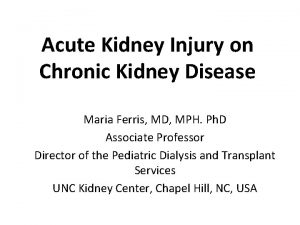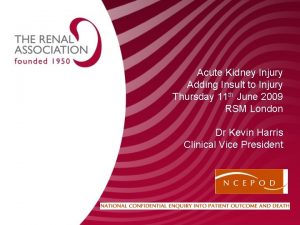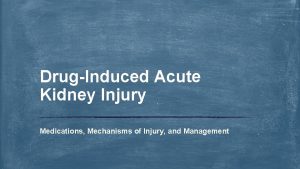Acute Kidney Injury Dr Alexis Missick FY 2
















- Slides: 16

Acute Kidney Injury Dr Alexis Missick FY 2

Presentation • • • Case Objectives Definition & Aetiology Investigation Management Complications

Clinical Scenario • History: 55 year old lady presents to A&E with a 5 day history of diarrhoea and vomiting. She believes this was caused by a Chinese take away she had a day before developing symptoms. She has been unable to keep anything down including water and now feels very poorly. • PMHx: HTN managed with ramipril. • SHx: non-smoker, drinks alcohol occasionally. • O/E: she appears very dry and has reduced skin turgor. BP is 100/70 and HR 95. Examination is otherwise unremarkable

Differentials?

Clinical Scenario • History: 55 year old lady presents to A&E with a 5 day history of diarrhoea and vomiting. She believes this was caused by a Chinese take away she had a day before developing symptoms. She has been unable to keep anything down including water and now feels very poorly. • PMHx: HTN managed with ramipril. • SHx: non-smoke, occasional alcohol. • O/E: she appears very dry and has reduced skin turgor. BP is 100/70 and HR 95. Examination is otherwise unremarkable • Ix: normal FBC, Na 149, K 6. 7, Urea 17. 0 and Creatinine 258

Objectives • Recognition of AKI • Learn classification of causes and common examples • Identification of appropriate investigations • Understand principles of management of AKI • Knowledge of indications for dialysis • Awareness of complications and management of hyperkalaemia (common complication)

Definition • Rapid impairment in renal function resulting in raised plasma urea/creatinine, fluid and/or acid-base imbalance which is reversible. • AKIN Criteria for diagnosis of AKI 1. Time course – rapid (<48 hours) 2. Reduction in Kidney function 1. 2. Rise in serum creatinine (absolute increase of >0. 3 mg/dl or percentage increase of > 50%) Reduction in urine output (<0. 5 ml/kg/hr for >6 hours) • RIFLE criteria (prosposed by ADQI) for staging of AKI: Risk, Injury, Failure, Loss, End stage kidney disease

Staging RIFLE Criteria • Proposed by ADQI • Severity (Stage 1 -3) – Risk: GFR decrease >25%, serum creatinine increased 1. 5 times OR urine production of <0. 5 ml/kg/hr for >6 hours – Injury: GFR decrease >50%, doubling of creatinine OR urine production <0. 5 ml/kg/hr for 12 hours – Failure: GFR decrease >75%, >tripling of creatinine or creatinine >355 μmol/l (>4 mg/dl) OR urine output below 0. 3 ml/kg/hr for 24 hours • Outcome – Loss: persistent AKI or complete loss of kidney function for more than 4 weeks – End-stage renal disease: need for renal replacement therapy (RRT) for more than 3 months

Aeitology http: //www. medicalassessmentonline. net/terms. php? R=3

Presentation • Symptoms – – – Malaise Anorexia, Nausea and Vomiting Pruritis Dehydration Confusion, convulsions • Signs – Hypertension – Fluid overload: peripheral oedema, SOB/ bibasal crackles/raised JVP – Dehydration: postural hypotension, poor urine output (palpable bladder)

Investigations • Bedside: BP (lying and standing), urine dip (? haematuria ? proteinuria), ECG • Biochemistry: ABG, FBCs, U+Es, LFTs, CRP/ESR, Ca 2+, blood culture • Imaging: CXR, USS KUB or CT KUB • Special tests: – CK, blood film, Myeloma screen (Bence-Jones protein), Renal Screen (ANA, ANCA, anti-BM) – Urine osmolality and cast cells – Renal biopsy – Doppler Renal USS and/or Angiography

Management • Assess fluid status • Fluid resuscitation • Stop nephrotoxic drugs • Treat the cause – Infection – give antibiotics, renal doses – Intrinsic renal disease – R/v medication – Obstruction- ? catheters ? calculus removal ? nephrostomies ? surgery

Complications – Indication for Immediate Dialysis!! • Hyperkalaemia (persistent >7 mmol/L) • Metabolic Acidosis (if p. H<7. 2, bicarbonate <12) • Pulmonary Oedema (refractory) • Pericarditis • Symptomatic ureamia - Encephalopathy http: //homeopathyexpert. blogspot. co. uk/2011/05/chronic-renal-failure. html

Hyperkalaemia • Potassium range is 3. 5 – 5 mmol/L • Rise in serum K+ >5 mmol/l • Signs/symptoms: muscle weakness • ECG changes: – Flattened P waves – Broad QRS complex – Slurring of ST segment – Tall tented T waves http: //www. aafp. org/afp/2006/0115/p 283. html

Hyperkalaemia • Potassium >6. 0 mmol/L – Calcium resonium 15 g QDS PO – If septic or rising quickly treat as though K+ 6. 5 • Potassium >6. 5 mmol/L – Dextrose-insulin (50 ml 50% Dextrose with 10 units Actrapid insulin, IV over 5 mins) Monitor BM – Calcium resonium 15 g QDS PO

Hyperkalaemia • Potassium >7 mmol/L – Calcium gluconate (10 ml of 10% solution into central vein or diluted into 40 ml 0. 9% saline into peripheral vein over 10 mins, with cardiac monitor) – Dextrose insulin – Nebulised salbutamol 5 mg – IV sodium bicarbonate (50 ml 8. 4% over 5 mins centrally or 500 mls 1. 26% over 30 mins peripherally – Calcium resonium
